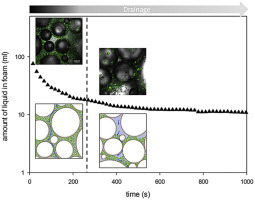当前位置:
X-MOL 学术
›
Food Hydrocoll.
›
论文详情
Our official English website, www.x-mol.net, welcomes your feedback! (Note: you will need to create a separate account there.)
Reprint of: Microstructural design of aerated food systems by soft-solid materials
Food Hydrocolloids ( IF 10.7 ) Pub Date : 2018-05-01 , DOI: 10.1016/j.foodhyd.2017.07.030 A. Lazidis , L. de Almeida Parizotto , F. Spyropoulos , I.T. Norton
Food Hydrocolloids ( IF 10.7 ) Pub Date : 2018-05-01 , DOI: 10.1016/j.foodhyd.2017.07.030 A. Lazidis , L. de Almeida Parizotto , F. Spyropoulos , I.T. Norton

|
Abstract The mechanism of adsorbing particles in creating super stable bubbles has been underlined and described but designing particles with these characteristics based of food grade materials is still a challenge. Moreover, food systems are rarely “pure” and the presence of more than one functional ingredients at a given formulation is usually the norm. This highlights the importance of mixed systems where particles and surface active ingredients are present. It has been demonstrated that particles made from food based materials although often not able to stabilised foams on their own, mostly due to limitations in size and hydrophobicity, they can aid significantly in the stability of foams without their ability to adsorb on the interface being a limiting factor. Evidence is presented where particles made from protein (whey) and hydrocolloid (κ-carageenan) sources can significantly extend the life of foams by affecting the rheological properties of these systems in both a macro and micro level. The technology of creating fluid gels poses an advantage in the production of these particles in a scalable manner that can provide solutions for industrial applications that demand liquid and powder formulations. The importance of surfactants (high or low molecular weight) that are either intrinsically present or added in the systems is also being underlined. Finally, a universal mechanism is proposed which allows the design of particulate systems from soft-solid materials that can produce edible liquid foams with enhanced stability.
中文翻译:

转载:软固体材料充气食品系统的微观结构设计
摘要 已经强调和描述了吸附颗粒产生超稳定气泡的机制,但基于食品级材料设计具有这些特性的颗粒仍然是一个挑战。此外,食品系统很少是“纯”的,在给定的配方中存在一种以上的功能成分通常是常态。这突出了存在颗粒和表面活性成分的混合系统的重要性。已经证明,由食品基材料制成的颗粒虽然通常不能单独稳定泡沫,主要是由于尺寸和疏水性的限制,但它们可以显着地帮助泡沫的稳定性,而不会吸附在界面上限制因素。有证据表明,由蛋白质(乳清)和水胶体(κ-角叉胶)来源制成的颗粒可以通过在宏观和微观层面影响这些系统的流变特性来显着延长泡沫的寿命。创建流体凝胶的技术在以可扩展的方式生产这些颗粒方面具有优势,可以为需要液体和粉末配方的工业应用提供解决方案。系统中固有的或添加的表面活性剂(高或低分子量)的重要性也得到了强调。最后,提出了一种通用机制,允许从软固体材料设计颗粒系统,该系统可以生产具有增强稳定性的可食用液体泡沫。
更新日期:2018-05-01
中文翻译:

转载:软固体材料充气食品系统的微观结构设计
摘要 已经强调和描述了吸附颗粒产生超稳定气泡的机制,但基于食品级材料设计具有这些特性的颗粒仍然是一个挑战。此外,食品系统很少是“纯”的,在给定的配方中存在一种以上的功能成分通常是常态。这突出了存在颗粒和表面活性成分的混合系统的重要性。已经证明,由食品基材料制成的颗粒虽然通常不能单独稳定泡沫,主要是由于尺寸和疏水性的限制,但它们可以显着地帮助泡沫的稳定性,而不会吸附在界面上限制因素。有证据表明,由蛋白质(乳清)和水胶体(κ-角叉胶)来源制成的颗粒可以通过在宏观和微观层面影响这些系统的流变特性来显着延长泡沫的寿命。创建流体凝胶的技术在以可扩展的方式生产这些颗粒方面具有优势,可以为需要液体和粉末配方的工业应用提供解决方案。系统中固有的或添加的表面活性剂(高或低分子量)的重要性也得到了强调。最后,提出了一种通用机制,允许从软固体材料设计颗粒系统,该系统可以生产具有增强稳定性的可食用液体泡沫。


























 京公网安备 11010802027423号
京公网安备 11010802027423号